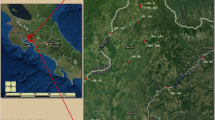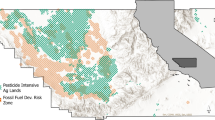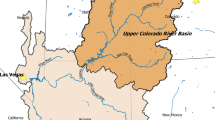Abstract
Little research has considered how residents’ perceptions of their local environment may interact with efforts to increase environmental concern, particularly in areas in need of remediation. This study examined the process by which local environmental action may affect environmental concern. A model was presented for exploring the effects of community-based watershed organizations (CWOs) on environmental concern that also incorporates existing perceptions of the local environment. Survey data were collected from area residents in two watersheds in southwestern Pennsylvania, USA, an area affected by abandoned mine drainage. The findings suggest that residents’ perceptions of local water quality and importance of improving water quality are important predictors of level of environmental concern and desire for action; however, in this case, having an active or inactive CWO did not influence these perceptions. The implications of these findings raise important questions concerning strategies and policy making around environmental remediation at the local level.


Similar content being viewed by others
Notes
The “no control” response and the “don’t know/no opinion response” were compared across numerous other indicators within the survey using a Chi-squared test for possible differences. To test if respondents’ attitudes were significantly different based on whether they answered 4 or 5, a variable was created in which respondents answering 4 were coded as 0 and respondents answering 5 were coded as 1. Then a series of crosstabs using this variable and numerous other survey questions were computed. The results of each comparison showed no significant difference in response, as evidenced by insignificant chi square statistics, based on whether an individual chose the “don’t know/no opinion” or the “no control” option. This suggests that these two categories could be combined without significantly misrepresenting the data. Accordingly, the don’t know/no opinion response was combined with the “no control” response to create a four-point scale for perceived level of concern.
References
Armstrong A, Stedman R, Bishop J, Sullivan P (2012) What’s a stream without water? Disproportionality in headwater regions impacting water quality. Environ Manag 50(5):849–860
Azjen I (1991) Theory of planned behavior. Organ Behav Hum Decis Process 50:179–211
Bickerstaff K (2004) Risk perception research: socio-cultural perspectives on the public experience of air pollution. Environ Int 30:827–840
Bonaiuto M, Carrus G, Martorella H, Bonnes M (2002) Local identity processes and environmental attitudes in land use changes: the case of natural protected areas. J Econ Psychol 23:631–653
Braiser K, Lee B, Stedman and Weigle J (2011) Local champions speak out: Pennsylvania’s community watershed organizations. In: Morton L, Brown S (eds) Pathways for getting to better water quality: the citizen effect. Springer, New York, pp 133–144
Brehm J, Eisenhauer B, Krannich R (2006) Community attachments as predictors of local environmental concern: the case for multiple dimensions of attachment. Environ Behav 37(2):237–257
Brody S, Highfield W, Peck B (2005) Exploring the mosaic of perceptions for water quality across watersheds in San Antonio, Texas. Landsc Urban Plan 73:200–214
Brown G, Harris G, Reed P (2002) Testing a place-based theory for environmental evaluation: an Alaska case study. Appl Geogr 22(1):49–76
Carrus G, Bonaiuto M, Bonnes M (2005) Environmental concern, regional identity and support for protected areas in Italy. Environ Behav 37(2):237–257
Cline SA, Collins AR (2003) Watershed associations in West Virginia: their impact on environmental protection. J Environ Manag 67(4):373–383
Community Survey of Perceived Environmental Health Risks in Western Australia (2009) Government of Western Australia Department of Health. www.public.health.wa.gov.au. Accessed May 2010
Corraliza J, Berenguer J (2000) Environmental values, beliefs, and actions: a situational approach. Environ Behav 32(6):832–848
Davidson D, Freudenburg W (1996) Gender and environmental risk concerns: a review and analysis of available research. Environ Behav 28(3):302–339
Day R (2007) Place and the experience of air quality. Health Place 13:249–260
Dietz T, Stern P, Guagnano G (1998) Social structural and social psychological bases for environmental concern. Environ Behav 30(4):450–471
Dunlap R, Jones R (2002) Environmental concern: conceptual and measurement issues. In: Dunlap R, Michelson W (eds) Handbook of environmental sociology. Greenwood Press, Westport, pp 482–524
Dunlap R, Van Liere K, Martig A, Jones R (2000) New trends in measuring environmental attitudes: measuring endorsement of the new ecological paradigm: a revise NEP scale. J Soc Issues 56(3):425–442
Fielding K, McDonald R, Louis W (2008) Theory of planned behavior, identity and intentions to engage in environmental activism. J Environ Psychol 28:318–326
Flynn J, Slovic P, Mertz CK (1994) Gender, race, and perception of environmental health risks. Risk Anal 14(6):1101–1108
Fransson N, Garling T (1999) Environmental concern: conceptual definitions, measurement methods and research findings. J Environ Psychol 19(4):369–382
Gregory G, Di Leo M (2003) Repeated behavior and environmental psychology: the role of personal involvement and habit formation in explaining water consumption. J Appl Soc Psychol 33(6):1261–1296
Griffin C (1999) Watershed councils: an emerging form of public participation in natural resource management. J Am Water Resour Assoc 35(3):505–518
Gunter V, Kroll-Smith S (2007) Volatile places: a sociology of communities and environmental controversies. Pine Forge Press, Thousand Oakes
Harris H (1999) Keystone of democracy: a history of Pennsylvania workers. Pennsylvania Historical and Museum Commission
Higdon F, Brasier K, Stedman R, Lee B, Sherman S (2005) Assessment of community watershed organizations in rural Pennsylvania. Center for Rural Pennsylvania. www.ruralpa.org/watersjes_higdon.pdf
Hu A, Morton L (2011) Regional water quality concern and environmental attitudes. In Morton L, Brown S (eds) Pathways for getting better water quality: the citizen effect. Springer, New York, pp 95–107
Irwin A, Simmons P, Walker G (1999) Faulty environments and risk reasoning: the local understanding of industrial hazards. Environ Plan A 31:1311–1326
Kaiser F, Scheuthle H (2003) Two challenges to a moral extension of the theory of planned behavior: moral norms and just world beliefs in conservatism. Personal Individ Differ 35(5):1033–1048
Karp D (1996) Values and their effect on pro-environmental behavior. Environ Behav 28(1):111–133
Kasapoğlu M, Ecevit M (2002) Attitudes and behavior toward the environment: the case of Lake Burdur in Turkey. Environ Behav 34:363–377
Kenney, DS (2000) Are community watershed groups effective? Confronting the Thorny issue of measuring success. In: Brick P, Snow D, Van de Wetering S (eds) Across the great divide: explorations in conservation and the American. West Island Press, Washington, DC, pp 188–193
Koehler B, Koontz T (2008) Citizen participation in collaborative watershed partnerships. Environ Manag 41:143–154
Kollmuss A, Agyeman J (2002) Mind the gap: why do people act environmentally and what are the barriers to pro-environmental behavior? Environ Educ Res 8(3):239–260
Leach W, Pelkey N (2001) Making watershed partnerships work: a review of the empirical literature. J Water Resour Plan Manag 127(6):378–390
Leach W, Pelkey N, Sabatier P (2002) Stakeholder partnerships as collaborative policymaking: evaluation criteria applied to watershed management in California and Washington. J Policy Anal Manag 21(4):645–670
Marshall B, Picou J, Bevc C (2005) Ecological disaster as contextual transformation: environmental values in a renewable resource community. Environ Behav 37(5):706–728
Masuda J, Garvin T (2006) Place, culture and the social amplification of risk. Risk Anal 26(2):437–454
McSpirit S, Reid C (2011) Resident’s perception of tap water and decisions to purchase bottled water: a survey analysis from Appalachian, Big Sandy Coal Mining Region of West Virginia. Soc Nat Resour 24(5):511–520
McSpirit S, Scott S, Gill D, Hardesty S, Sims D (2007) Risk perceptions after a coal waste impoundment failure: a survey assessment. South Rural Sociol 22(2):83–110
Moore E, Koontz T (2003) Research note a typology of collaborative watershed groups: citizen-based, agency-based, and mixed partnerships. Soc Nat Resour 16(5):451–460
Moore R, Weaver M (2006) Upper sugar creek survey. In: Parker J (ed) Land tenure in the sugarcreek watershed: a contextual analysis of land tenure and social networks, intergenerational farm succession, and conservation use among farmers of Wayne County, Ohio. Dissertation, The Ohio State University
Morton L (2008) The role of civic structure in achieving performance-based watershed management. Soc Nat Resour 21:751–766
Pennsylvania Department of Environmental Protection (1998) Pennsylvania Integrated Water Quality Monitoring an Assessment Report. www.dep.state.pa.us. Accessed April 2010
Pennsylvania Department of Environmental Protection (2006) Acid Mine Drainage Set Aside Program www.dep.state.pa.us. Accessed June 2011
Pennsylvania Department of Environmental Protection (2011) www.dep.state.pa.us. Accessed 4 June 2011
Poortinga W, Steg L, Vlek C (2004) Values, environmental concern, and environmental behavior: a study into household energy use. Environ Behav 36(1):73–90
Riley P, Kiger G (2002) Increasing survey response: the Drop-Off/Pick-up technique. Rural Sociol 22(1):6–9
Schultz W, Zelezny L (1999) Values and pro-environmental behavior: a 5 country survey. J Cross Cult Psychol 29(4):540–558
Schumacker R, Lomax R (2004) A beginner’s guide to structural equation modeling. Lawrence Erlbaum, Mahwah
Slovic P, Peters E (2006) Risk perception and affect. Curr Dir Psychol Sci 15(6):322–325
Stedman R, Lee B, Braiser K, Weigle J, Higdon F (2009) Cleaning up water? OR building rural community? Community watershed organizations in Pennsylvania. Rural Sociol 74(2):178–200
Stern P (2000) New environmental theories: toward a coherent theory of environmental significant behavior. J Soc Issues 56(3):407–424
Stern P, Dietz T, Kalof L, Guagnano G (1995) Values, beliefs, and pro-environmental action: attitude formation toward emergent objects. J Appl Soc Psychol 25(18):1611–1636
Stoll-Kleeman S (2001) Barriers to nature conservation in Germany: a model explaining opposition to protected areas. J Environ Psychol 21:369–385
Story P, Forsyth D (2008) Watershed conservation and preservation: environmental engagement as helping behavior. J Environ Psychol 28(4):305–317
Stough-Hunter A (2011) Examining the role of community and gender on perceptions of impaired water quality: a comparative case study. Dissertation, The Ohio State University
United States Census (2010) www.census.gov. Accessed April 2010
U.S. Geological Survey (2011) www.streamstats.usgs.gov. Accessed June 2011
Uzzell D, Pol E, Badenas D (2002) Place identification, social cohesion and environmental sustainability. Environ Behav 34(1):26–53
Vorkinn M, Riese H (2001) Environmental concern in a local context: the significance of place attachment. Environ Behav 33(2):249–263
Weber E (2000) A new vanguard for the environment: grass–roots ecosystem management as a new environmental movement. Soc Nat Resour 13:237–259
Xiao C, McCright A (2007) Environmental concern and sociodemographic variables: a study of statistical models. J Environ Educ 38(2):3–13
Acknowledgments
A number of individuals and organizations served as valuable resources for the project. Specifically, we would like to thank the Pennsylvania Department of Environmental Protection, the township supervisors, the watershed organization personnel, and a key individual with the conservation district of the county under study who provided valuable information throughout the project. Dr. Richard Moore and Dr. Tom Koontz gave thoughtful feedback on the research. Kathy Stough aided with survey distribution.
Funding
No funding was obtained for this research.
Author information
Authors and Affiliations
Corresponding author
Rights and permissions
About this article
Cite this article
Stough-Hunter, A., Lekies, K.S. & Donnermeyer, J.F. When Environmental Action Does Not Activate Concern: The Case of Impaired Water Quality in Two Rural Watersheds. Environmental Management 54, 1306–1319 (2014). https://doi.org/10.1007/s00267-014-0370-3
Received:
Accepted:
Published:
Issue Date:
DOI: https://doi.org/10.1007/s00267-014-0370-3




